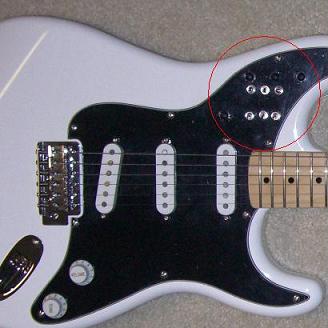NAMM Log #2: Are Awesome Guitars as Awesome as Tom Says?
(ShackMan | Posted 2010-07-12)

Thomas Wnorowski had a pretty sweet idea when he named his company “Awesome Guitars.” It’s catchy, and the title speaks for itself. Maybe those words don’t go together as often as they should. But when he refers to his own product as “arguably the greatest invention since Les Paul invented the solid body electric guitar in 1941,” he issued the kind of statement that begged for that argument to happen. In all fairness, I don’t think anything other than perhaps the very first Fender Precision bass could be called the “greatest invention since” yadda yadda yadda, so let’s just take a look at what Awesome Guitars is all about and find out if it’s worth taking one home. Cool?
The premiere product of Awesome Guitars is the “Patented Switching System” which claims to turn any 3-pickup guitar into a powerhouse with 35 pickup tones. They are also made for two pickup guitars, in which case the switching system advertises 6 tones after the product is installed. The only thing the Switching System adds are a series of 4 or 6 switches depending on the number of pickups you already have on your instrument (two switches per pickup). One row controls whether each pickup is in series, parallel, or off, and the other controls whether the pickup is in phase or out of phase. All this product replaces is your original pickup switch or blend knob. Keep your pickups and pre-amp and just drop in a new pickguard with the switches pre-wired.

When I saw Thomas at his booth at NAMM, he was displaying his own brand of guitars and basses all bearing the Awesome Guitars logo on the headstock. I got to demo the switching system, but only on one of the headphone amplifiers that he brought with him. Next time, I hope he brings a combo or something with him so that I can actually hear the difference on a real amplifier. The bass itself was not of bad quality, although the neck was a bit uneven and I did notice that the fret job wasn’t the best. On a $1,600 instrument, that’s a problem that Thomas should look into addressing immediately. Still, it was playable, and felt comfortable in my hands.
To be fair, having a full 35 tones in one guitar could be a great help, and although its fairly obvious if you read some of the lines on the Awesome Guitars website that the system is over-hyped (Thomas writes at one point that “this is the pre-amp that Leo Fender MEANT to use when he first started building guitars), I’m curious as to what it actually sounds like through my own home rig and what it’s like to switch in a live situation. His is an intriguing idea, albeit one that brings with it its own problems.
My biggest question is how he expects that simply turning pickups from series to parallel or in and out of phase will simulate all the tones stated (possibly just another bit of over-hype), when there are other obstacles that aren’t even considered. So much of the tone comes from the use of different woods, different weights, different preamps, and dozens of other factors that influence the way a guitar sounds. Does the Patented Switching System even recreate the sounds that Thomas claims it can? Also, at $1,600 a pop, why shouldn’t I simply buy a Les Paul Special for $600 and a Fender Stratocaster for $400 and save myself some dough in the process? The same concept goes for the bass. I can purchase a P-Bass and a Jazz bass for under $1,000. What makes me want to spend the extra money?
These questions and more new questions will be answered when I get my hands on one for a full-on test drive.
James Rushin is a bassist, keyboardist, writer, and composer living and working in the Greater Pittsburgh area. He has performed with Selmer artist Tim Price, Curtis Johnson, guitarists Ken Karsh and Joe Negri, and his compositions have been featured at West Virginia University and Valley Forge Christian College. His contest winning essays and short stories have seen publication in and around the Tri-State area.
Feel free to e-mail James with comments, questions, concerns, and ideas at james.rushin@musicgearreview.com.




